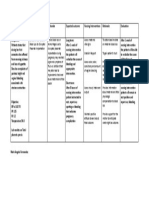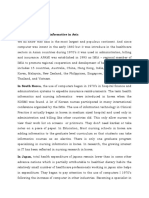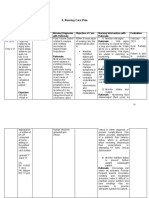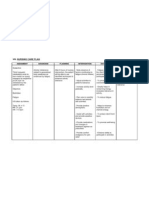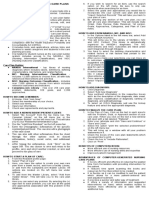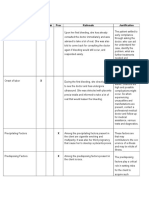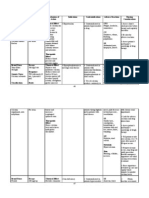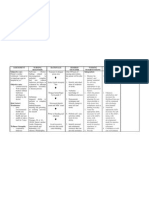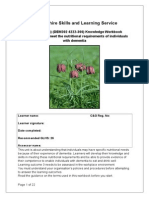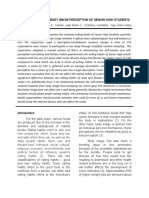Health Teaching Plan
Health Teaching Plan
Uploaded by
Paolo Vittorio Perdigueros GonzalesCopyright:
Available Formats
Health Teaching Plan
Health Teaching Plan
Uploaded by
Paolo Vittorio Perdigueros GonzalesCopyright
Available Formats
Share this document
Did you find this document useful?
Is this content inappropriate?
Copyright:
Available Formats
Health Teaching Plan
Health Teaching Plan
Uploaded by
Paolo Vittorio Perdigueros GonzalesCopyright:
Available Formats
44 X.V Health Teaching Plan Medication 1.
Generic name: Losartan potassium Exercise Exercise plays its part in the treatment of lupus. It is very important to keep Brand name: Cozaar muscles & joints active for a variety of reasons. C: Anti-hypertensive Muscles need to be drug toned in order to function adequately. The H: Lowers high blood size of the muscle & its pressure blood circulation depend on its function (where E: Not affected by meals. the muscle is & what it It is given once a day does). Physical therapy (OD). is very beneficial to the patient who is trying to C: Tell patient to avoid maintain muscle salt substitutes; these integrity & tone. Joints products may contain depend on tendons & the potassium, which can calcification of bones. cause high potassium These in turn depend on level. continued movement. Significant bone loss K: Monitor patients through osteoporosis blood pressure to evaluate occurs when bones are effectives of drug therapy. not used regularly. When used alone, drug Encourage significant has less of an effect on other to do passive blood pressure ROM (Range of motion) exercises for the client. 2. Generic Name: Treatment Angina medications Nitrates: Commonly known as nitroglycerin, nitrates are the most commonly prescribed drugs to treat angina. Nitrates dilate blood vessels, which allow more blood to flow past blockages. Nitrates also decrease the resistance the heart faces when pumping blood to the rest of the body, which in turn can decrease the stress (workload) on the heart. Beta-blockers: Beta-blockers slow the heart rate and decrease the force of heart muscle contraction, thereby reducing the stress on the heart. Hygiene Every external part of the body demands a basic amount of attention on a regular basis. Here are some grooming routines: 1. Taking a bath everyday 2. Keep nails short and trimmed to prevent excoriation. A healthy body ensures healthy nails. Brittle or discoloured nails show up deficiencies or disease conditions. Outpatient The best way to prevent angina is to lower your risk for coronary heart disease: Avoid or reduce stress as much as you can. Control your blood pressure, diabetes, and cholesterol. Eat well-balanced meals that are low in fat and cholesterol and include several daily servings of fruits and vegetables. Diet Dietary guidelines for those who have angina include: Control calories: Eat just enough calories to achieve and maintain a healthy weight. Eat quality fats: Use virgin olive oil and other unsaturated, lowcholesterol fats. Eat foods that are rich in omega-3 fatty acids Eat the right amount of fats, carbohydrates and protein: Limit your fat intake to 20 or 30 percent, but don't substitute simple carbohydrates for fat. Less than 7% of the day's total calories from saturated fat. Up to 10% of the day's total calories from polyunsaturated fat. Up to 20% of the day's total calories from monounsaturated fat Avoid fad diets:
Get regular exercise. If your weight is normal, 3. Keep hair clean and get at least 30 minutes of moisturized. Wash your exercise every day. hair at least once a However, talk to your week using soap or doctor before starting mild shampoo. Avoid exercise or increasing shampoos with borax your activity level. or alkalis. Calcium channel Lose weight if you blockers: 4. Provide or encourage are overweight. Calcium channel blockers oral hygiene cause blood vessels to Stop smoking
45 Diazepam Brand Name: Valium C: Central nervous system drug; Anxiolytic H: It is effective if it relieved symptoms of anxiety, acute agitation, tremor, delirium tremens, and hallucination and relaxes muscle. E: Not affected by meals. It is given twice a day (BID). Tell patient to avoid alcohol while taking drug. C: Warn patient to avoid acivities that require mental alertness and good coordination until effects of drug are known. K: Monitor periodic hepatic, renal and hematopoietic function studies in patients receiving repeated or prolonged therapy. 1. Musculoskeletal activity (designed to enhance flexibility & mobility) Types of Activities: Passive ROM Exercises Duration: 10-15 minutes Frequency: Everyday, 2-4 hours 2. Stretching Exercises (to specifically target joint weakness) Types of Activities: Chin-to-chest. Raise the back of the person's head up from the bed. Gently tip his chin toward his chest. Try to rest the person's chin on his chest if possible. Head turns. Put one hand on each side of the person's face. Turn the person's head toward the right as if he were looking over his right shoulder. Then slowly dilate and blood pressure to decrease, and they also reduce the frequency and severity of angina by reducing the stress on the heart. Electrocardiogram (ECG) ECG tests monitor the electrical activity of the heart. When certain ECG findings are present, the risk of unstable angina progressing to a heart attack is significantly increased. Cardiac blood tests Since unstable angina can be a precursor for a heart attack, a physician will usually order blood tests to determine if a heart attack has occurred. The test looks for evidence that heart muscle has died. Usually, several blood tests have to be checked over a period of several hours, since evidence of a heart attack can take some time to Get enough sleep and rest. Adherence to pharmacological and non-pharmacological interventions. Stress to patient and family the importance of follow-up examinations and treatment because of changing physical status. Allowing monitoring of symptoms, disease activities, and treatment of side effects. Eat a well-rounded diet instead. Eat small, frequent meals. Avoid large and heavy meals. Limit cholesterol in diet: To less than 200 milligrams a day. Limit iron intake: Too much iron can increase atherosclerosis. Eat enough dietary fiber: Whole grains are best. Eat plenty of fresh fruit and vegetables Reduce salt in your diet Optimal: no more than 1,500 milligrams per day. Check with your doctor about supplementing your diet with B vitamins: Vitamin B1 (thiamine) Vitamin B2 (riboflavin) Vitamin B3 (niacin) Vitamin B5 (pantothenic acid) Vitamin B6 (pyridoxine) Vitamin B12 (cobalamin)
46 turn the person's head so he is looking over his left shoulder. Turn the head only far enough so that the person's nose is lined up above their shoulder. Head tilts. Put one of your hands on each side of the person's face. Tilt the head to the side, bringing the right ear toward the right shoulder. Then slowly tilt the person's head to bring the left ear toward the left shoulder. Intensity: Start with minimal stretching, gradually increasing Duration: 15-20 minutes Frequency: 2-4 times a week 3.Ankle & Foot Exercises appear in the blood. Knowing the results of these tests is important in determining the next best cardiac test or treatment to have. Cardiac catheterization and angiography Physicians may recommend cardiac catheterization and angiography, especially if significant resting ECG changes are present or cardiac blood tests are abnormal. During angiography, a catheter is inserted into an artery in the groin or arm and advanced into the heart. When the catheter is positioned near the arteries that supply blood to the heart, the physician injects a contrast dye. As the dye travels through the arteries, X-ray pictures are taken to see how well blood flows through the arteries, and if there are any blockages that indicate CAD.
3 Generic Name: Captopril Brand Name: Capoten C: Angiotensinconverting enzyme (ACE)inhibitor; Antihypertensive H: Treat CHF in patients unresponsive to conventional therapy; used with diuretics and digitalis, diabetic nephropathy and left ventricular dysfunction after MI. E Given twice a day (BID). Administer 1 hour before or 2 hours after meals. C: Tell patient to report any signs of toxicity, mouth sores; sore throat, fever, chills; swelling of the hands, feet; irregular heartbeat, chest pains; swelling of the face, eyes, lips, tongue, difficulty
47 breathing. K: Monitor patient closely for fall in BP secondary to reduction in fluid volume (excessive perspiration and dehydration, vomiting, diarrhea); excessive hypotension may occur. 4 Generic Name: Potassium chloride Brand Name: Kalium durule C: Electrolyte and replacement solution H: Prevent hypokalemia E: Not affected by meals. Given twice a day (BID).. C: Teach patient signs and symptoms of hyperkalemia and tell patient to notify prescriber if they occur. K: Watch out for levels Types of Activities: How to start: Hold the right ankle with one hand. Put your other hand on the bottom of the foot. Ankle bends. Push the person's foot so his toes point up toward the ceiling. Then put your hand on top of the foot and push the foot down again. Ankle rotation. Hold the ankle with one hand. Hold the person's upper foot with your other hand. Gently turn the foot and ankle in circles. Toe bends. With your palm on top of the person's foot, curl the toes down toward the sole (bottom) of the foot. Then straighten and stretch the toes. Toe spreads. Use your fingers to spread the toes apart one at a time. Then bring them together again. Intensity: Gradually increasing
ECG stress test In an ECG stress test, the patient exercises, usually by walking on a treadmill, while wearing an ECG monitor. If the heart is not receiving sufficient oxygen during the exercise, the ECG patterns reflect this and indicate the presence of CAD. If a person is unable to perform enough exercise to stress the heart adequately during a stress test, a drug designed to mimic the effects of exercise on the heart can be administered instead. Nuclear stress test A nuclear stress test is similar to an ECG stress test. However, during the exercise, a radioisotope (a safe radioactive compound) is injected into a vein and travels to the arteries that supply blood to the heart. After exercise, pictures of the
48 of potassium electrolyte level to prevent hyperkalemia 5. Generic Name: Isosorbide dinitrate Brand Name: Isoket C: Cardiovascular system drug; Anti-anginal H: Treatment and prevention of angina pectoris. E: Give oral preparations on an empty stomach, 1 hour before or 2 hours after meals; take with meals if severe, uncontrolled headache occurs. Given thrice a day (TID). C: Patients should be told that the anti-anginal efficacy of isosorbide dinitrate is strongly related to its dosing regimen, so the prescribed schedule of dosing should be followed carefully. from soft to moderate pressure. Duration: 2-3 Sessions, 15-20 minutes a day Frequency: 2-4 times a week. Consultation must be done first before engaging to any exercise programs. This is to ensure the safety and limitations of exercises intended for end stage renal disease patients. Encourage significant other (wife) to do ROM (range of motion) exercises on the time required to prevent immobility of the patient. Instruct significant other to perform proper stretching and warm up activities before engaging patient to a higher intensity ROM exercises. heart are taken with a special camera that can detect the radioisotope. These pictures can determine if blockages from CAD are present. Echocardiographic stress testing An echocardiographic, or echo, stress test is similar to an ECG stress test. An echo stress test uses ultrasound waves to take pictures of the heart before and after exercise, which can show changes that indicate the presence of CAD. ACTUAL
49 K: Monitor blood pressure, intensity and duration of drug response. 6. Generic name: Atorvastatin Calcium Brand name: Lipitor Antihyperlipidemic HMG-CoA reductase inhibitor C: Inhibits HMG-CoA reductase, the enzyme that catalyzes the first step in the cholesterol synthesis pathway, resulting in a decrease in serum cholesterol, serum LDLs (associated with increased risk of CAD), and increases serum HDLs (associated with decreased risk of CAD); increases hepatic LDL recapture H: >increase HDL-C E: Take the same time each day, preferably in
50 the evening; may be taken with food. C: Do not drink grape juice while taking this drug. Contraindicated with allergy to atorvastatin fungal byproducts, active hepatic disease, or unexplained and persistent elevations of transaminase levels K: Withhold atorvastatin in any acute, serious condition (severe infection, hypotension, major surgery, trauma, severe metabolic or endocrine disorder, seizures) that may suggest myopathy or serve as risk factor for development of renal failure Ensure that patient has tried cholesterol-lowering diet regimen for 3-6 months before beginning therapy Report muscle pain, weakness, tenderness;
51 malaise; fever; changes in color of urine or stool; swelling 7. Generic name: Clopidogrel Brand name: Plavix C: Adenosine diphophate (ADP) receptor antagonist antiplatelet inhibits platelet aggregation by blocking ADP receptors on platelets, preventing clumping of platelets H: > prevent adverse cardiac events in coronary stent implantation E: May be taken with meals C: Avoid taking with NSAIDs K: Monitor patient carefully; increased risk of GI bleeding when
52 taken with NSAIDs Report skin rash, chest pain, fainting, severe headache, abnormal bleeding 8. Generic name: nitroglycerin Brand name: Minitran, nitrek, nitrodur, transderm-nitro C: Antianginal Nitrate Relaxes vascular smooth muscle with a resultant decrease in venous return and decrease in arterial BP, which reduces left ventricular workload and decreases myocardial oxygen H: Prophylaxis of angina E: Apply to slightly different area each day. C: Remove old system before you apply a new one
53
K: Administer transdermal systems to skin site free of hair and not subject to much movement. Shave areas that have a lot of hair. Do not apply to distal extremities. Change sites slightly to decrease the chance of local irritation and sensitization. Remove transdermal system before attempting defibrillation or cardioversion.
You might also like
- Make Today Count - The Secret of - John MaxwellDocument132 pagesMake Today Count - The Secret of - John MaxwellDeepak Rana100% (20)
- NCP 3rd YearDocument6 pagesNCP 3rd YearTotoro AblogNo ratings yet
- Hypertension, Anxiety, Airway NCPDocument6 pagesHypertension, Anxiety, Airway NCPHana Sanchez AlobaidanNo ratings yet
- Diabetes Mellitus CPGDocument157 pagesDiabetes Mellitus CPGejikieru03100% (3)
- Intra NatalDocument1 pageIntra NatalIche Dela Cruz100% (1)
- Now, Try Some Big Leap.: Keep GoingDocument10 pagesNow, Try Some Big Leap.: Keep GoingCameron De GuzmanNo ratings yet
- Atrial Septal Defect - 7 Year OldDocument1 pageAtrial Septal Defect - 7 Year OldMSNo ratings yet
- Novilyn C. Pataray BSN - Ii Impetigo: St. Paul College of Ilocos SurDocument1 pageNovilyn C. Pataray BSN - Ii Impetigo: St. Paul College of Ilocos SurCharina AubreyNo ratings yet
- Health Teaching-Postpartum PreeclampsiaDocument3 pagesHealth Teaching-Postpartum PreeclampsiaLester Vince PansaNo ratings yet
- SDL 1Document2 pagesSDL 1Duchess Juliane Jose MirambelNo ratings yet
- Assessment Nursing Diagnosis Rationale Expected Outcome Nursing Interventions Rationale EvaluationDocument1 pageAssessment Nursing Diagnosis Rationale Expected Outcome Nursing Interventions Rationale EvaluationMark Fernandez100% (1)
- Assessment Diagnosis Rationale Planning Implementation Rationale EvaluationDocument2 pagesAssessment Diagnosis Rationale Planning Implementation Rationale Evaluationkristel_nicole18yahoNo ratings yet
- Precipitate LaborDocument2 pagesPrecipitate LaborDivina Gracia Vibal Cielo100% (1)
- Case Study Icu Sem 6Document30 pagesCase Study Icu Sem 6BM2-0619 Mohd Khairul Naaim Bin PenchariNo ratings yet
- NCP For Impaired Oral Mucous MembraneDocument11 pagesNCP For Impaired Oral Mucous MembraneRYAN SAPLADNo ratings yet
- NCP FinalDocument5 pagesNCP FinalVenus BonglayNo ratings yet
- Nursing Care Plan: Blood DyscariasDocument6 pagesNursing Care Plan: Blood DyscariasneuronurseNo ratings yet
- 4th Week - Nursing Care Plan - Ineffective ThermoregulationDocument2 pages4th Week - Nursing Care Plan - Ineffective ThermoregulationKeldy Currie SpainhourNo ratings yet
- Nursing Care To Promote Fetal and Maternal HealthDocument17 pagesNursing Care To Promote Fetal and Maternal HealthTrisha DionesNo ratings yet
- Date Cues Nursing Diagnosis Scientific Basis Goal of Care Nutsing Interventi ON Rationale EvaluationDocument5 pagesDate Cues Nursing Diagnosis Scientific Basis Goal of Care Nutsing Interventi ON Rationale EvaluationNathalie kate petallarNo ratings yet
- Assessment Nursing Diagnosis Planning Implementation Rationalization Evaluation Subjective: Short Term Goal: Independent Goal MetDocument1 pageAssessment Nursing Diagnosis Planning Implementation Rationalization Evaluation Subjective: Short Term Goal: Independent Goal MetKelsey MacaraigNo ratings yet
- Fluorosis: Fluoride Toxicity: Patient Management & MonitoringDocument24 pagesFluorosis: Fluoride Toxicity: Patient Management & MonitoringdrjriNo ratings yet
- Summary of Nursing Informatics in AsiaDocument2 pagesSummary of Nursing Informatics in AsiaJake Yvan Dizon0% (1)
- Physical Assessment For Mother With Gestational DiabetesDocument5 pagesPhysical Assessment For Mother With Gestational DiabetesDenise Garcia MolinaNo ratings yet
- NCP Anaphylactic ShockDocument6 pagesNCP Anaphylactic ShockKirstin del CarmenNo ratings yet
- Impaired Skin IntegrityDocument2 pagesImpaired Skin IntegrityVINCE ONATONo ratings yet
- High-Risk Pregnancy Premature Rupture of Membranes (PROM)Document3 pagesHigh-Risk Pregnancy Premature Rupture of Membranes (PROM)elimcangcoNo ratings yet
- LeopoldsDocument2 pagesLeopoldsMhianne SarmientoNo ratings yet
- NCP PPHDocument2 pagesNCP PPHMark Joseph Christian100% (1)
- BSN 2F - Drug StudyDocument5 pagesBSN 2F - Drug Study22 - Fernandez, Lyza Mae D.No ratings yet
- CHN Case Analysis Case ScenarioDocument7 pagesCHN Case Analysis Case ScenarioNathalie kate petallarNo ratings yet
- Group-5 - NCP - Ges HypDocument2 pagesGroup-5 - NCP - Ges HypWallen Jey Velasco100% (1)
- Oral Candidiasis Thrush StomatitisDocument11 pagesOral Candidiasis Thrush StomatitisJowckho Jack BushidoNo ratings yet
- Thalassemia Nursing Diagnosis and CareDocument1 pageThalassemia Nursing Diagnosis and CareHannah Clarisse Monge IgniNo ratings yet
- NCP High Risk PregnancyDocument7 pagesNCP High Risk PregnancyRica ParcasioNo ratings yet
- Viii. Nursing Care Plan: Asessment Diagnosis Planning Intervention Rationale EvaluationDocument3 pagesViii. Nursing Care Plan: Asessment Diagnosis Planning Intervention Rationale Evaluationhehehe29No ratings yet
- Ineffective BreastfeedingDocument16 pagesIneffective BreastfeedingGil Sunpayco Jr.No ratings yet
- BuscopanDocument2 pagesBuscopancen janber cabrillosNo ratings yet
- 4 Flow Chart PretermDocument4 pages4 Flow Chart PretermYeni PuspitaNo ratings yet
- Post Cs Na Revised Na TohDocument31 pagesPost Cs Na Revised Na TohMinerva CortalNo ratings yet
- Nursing Care Plan For Breast Cancer NCP PDFDocument2 pagesNursing Care Plan For Breast Cancer NCP PDFMaina BarmanNo ratings yet
- Components of Foood Home Work AdhritDocument3 pagesComponents of Foood Home Work AdhritMrudula GummuluriNo ratings yet
- NCP - PCGHDocument9 pagesNCP - PCGHLucelle ArellanoNo ratings yet
- H. Nursing Care Plan: Altered Parenting RoleDocument2 pagesH. Nursing Care Plan: Altered Parenting RoleClovie ArsenalNo ratings yet
- Computer Generated Nursing Care Plans OutlineDocument1 pageComputer Generated Nursing Care Plans OutlineEstelle Rhine100% (1)
- Module 5a Mat NCPDocument3 pagesModule 5a Mat NCPmen16_cantereNo ratings yet
- Criteria Good Fair Poor Rationale Justification XDocument3 pagesCriteria Good Fair Poor Rationale Justification XJaye DangoNo ratings yet
- MorphineDocument3 pagesMorphineAizat KamalNo ratings yet
- Virtual Clinical Duty Daily RequirementsDocument7 pagesVirtual Clinical Duty Daily RequirementsEdgie FabreNo ratings yet
- NCP Meningitis Sure NaniDocument2 pagesNCP Meningitis Sure NaniARISNo ratings yet
- Reviwer 29Document3 pagesReviwer 29chaSephNo ratings yet
- Minggu 5 LP Hiperemesis GravidarumDocument16 pagesMinggu 5 LP Hiperemesis GravidarumMuhammad PanduNo ratings yet
- Nursing Care Plan: Change in Health Status As Evidence by Excessive Shaking After 1hour, The Patient Will Be Able ToDocument1 pageNursing Care Plan: Change in Health Status As Evidence by Excessive Shaking After 1hour, The Patient Will Be Able ToVoid LessNo ratings yet
- HyperthermiaDocument2 pagesHyperthermiaLeolene Grace BautistaNo ratings yet
- Femur FractureDocument19 pagesFemur FractureMadx VNo ratings yet
- Research ProposalDocument22 pagesResearch ProposalKapil LakhwaraNo ratings yet
- 5NCPDocument4 pages5NCPSara ThorntonNo ratings yet
- Labor Induced AugmentedDocument9 pagesLabor Induced Augmentednursereview83% (6)
- Case Study On Spontaneous AbortionDocument14 pagesCase Study On Spontaneous AbortionAlphine DalgoNo ratings yet
- Ventricular Septal Defect, A Simple Guide To The Condition, Treatment And Related ConditionsFrom EverandVentricular Septal Defect, A Simple Guide To The Condition, Treatment And Related ConditionsNo ratings yet
- What Are The Signs and Symptoms of Heart Failure?Document4 pagesWhat Are The Signs and Symptoms of Heart Failure?Lara TechiesNo ratings yet
- D - C Planning TTCDocument10 pagesD - C Planning TTCvercia8877No ratings yet
- NCP and Drug Study For Case in SleDocument34 pagesNCP and Drug Study For Case in SlePaolo Vittorio Perdigueros GonzalesNo ratings yet
- NCP Acute Pain NCSDocument3 pagesNCP Acute Pain NCSPaolo Vittorio Perdigueros GonzalesNo ratings yet
- Jurisprudence 2 NotesDocument5 pagesJurisprudence 2 NotesPaolo Vittorio Perdigueros GonzalesNo ratings yet
- Drug Studies and Health Teaching PlanDocument28 pagesDrug Studies and Health Teaching PlansfkjalkhsafgNo ratings yet
- X. Pathophysiology Predisposing Factors: Precipitating FactorsDocument3 pagesX. Pathophysiology Predisposing Factors: Precipitating FactorsPaolo Vittorio Perdigueros GonzalesNo ratings yet
- HemophiliaDocument4 pagesHemophiliaPaolo Vittorio Perdigueros GonzalesNo ratings yet
- NCP RiskDocument2 pagesNCP RiskPaolo Vittorio Perdigueros GonzalesNo ratings yet
- NCP Actual 1Document2 pagesNCP Actual 1Paolo Vittorio Perdigueros GonzalesNo ratings yet
- 2024-IFIC-Food-Health-SurveyDocument104 pages2024-IFIC-Food-Health-Surveyrobertdice32No ratings yet
- Understand and Meet The Nutritional Requirements of Individuals With DementiaDocument22 pagesUnderstand and Meet The Nutritional Requirements of Individuals With DementiaJovana Ognenovska BakalovskaNo ratings yet
- ĐỀ TACN 2017 2018Document3 pagesĐỀ TACN 2017 2018Anime NoobNo ratings yet
- Diet PlanDocument6 pagesDiet Planmakeup vanityNo ratings yet
- Obesity Caused by HomeworkDocument7 pagesObesity Caused by Homeworkerfr8kf2100% (1)
- Ambassador EveningDocument11 pagesAmbassador Eveningakshayapril24No ratings yet
- Obesity ManagentDocument54 pagesObesity ManagentHugo David CoronelNo ratings yet
- nuRSING rEVIEWER PART 2Document9 pagesnuRSING rEVIEWER PART 2Johny VillanuevaNo ratings yet
- Squash Papaya ChipsDocument74 pagesSquash Papaya Chipsjanine barilla100% (2)
- Meal Prep For Weight LossDocument286 pagesMeal Prep For Weight LossJames Cabangon QuintoNo ratings yet
- Tao of Balanced Diet: Regular Food Diet For Health and BeautyDocument26 pagesTao of Balanced Diet: Regular Food Diet For Health and Beautycoquizzz100% (1)
- Physical Education 4Document2 pagesPhysical Education 4JOHN VINCENT ALBIOSNo ratings yet
- 2018 BodyTrustWorkbook - UpdateDocument12 pages2018 BodyTrustWorkbook - UpdateMichelle MillerNo ratings yet
- Quiz 1 Ingles A2Document18 pagesQuiz 1 Ingles A2Yeimin Andrea Gutierrez MondragonNo ratings yet
- Nutr 109 - Final Project - f2021Document5 pagesNutr 109 - Final Project - f2021Jackson VonkNo ratings yet
- A Survey On The Knowledge in General Population About Diabetes and LifestyleDocument4 pagesA Survey On The Knowledge in General Population About Diabetes and LifestyleInternational Journal of Innovative Science and Research TechnologyNo ratings yet
- PT A ExplDocument46 pagesPT A Explashu10mnNo ratings yet
- Final EssayDocument4 pagesFinal Essayapi-300982639No ratings yet
- Counselling About Diet 2009Document28 pagesCounselling About Diet 2009Lana LocoNo ratings yet
- Diabetes Reversal by Plant Based Diet Dr. BiswaroopDocument7 pagesDiabetes Reversal by Plant Based Diet Dr. Biswaroopsatya_vanapalli3422100% (1)
- S PSYC 515: Helpful Hints FOR Uccess INDocument3 pagesS PSYC 515: Helpful Hints FOR Uccess INAndy HermanNo ratings yet
- 1Document4 pages1Дмитро КазанцевNo ratings yet
- Pregnancy GuidelinesDocument2 pagesPregnancy Guidelinespainah sumodiharjo100% (2)
- Eating Habits and Body Image PerceptionsDocument16 pagesEating Habits and Body Image PerceptionscjnicoleNo ratings yet
- Letter Writing (Formal) For SBI PO, IBPS PO Mains Exams - Set 1Document62 pagesLetter Writing (Formal) For SBI PO, IBPS PO Mains Exams - Set 1Sakshi BhardwajNo ratings yet
- Gout Diet Mayo ClinicDocument3 pagesGout Diet Mayo ClinicNani Handayani RisandiNo ratings yet
- Muscle Gain Math - BodyrecompositionDocument3 pagesMuscle Gain Math - BodyrecompositionFake100% (1)
- Casereport-Modified Radical MastectomyDocument33 pagesCasereport-Modified Radical MastectomyMayflor de LunaNo ratings yet










